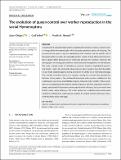| dc.contributor.author | Olejarz, Jason | en_US |
| dc.contributor.author | Veller, Carl | en_US |
| dc.contributor.author | Nowak, Martin A. | en_US |
| dc.date.accessioned | 2017-12-06T05:58:10Z | |
| dc.date.issued | 2017 | en_US |
| dc.identifier.citation | Olejarz, Jason, Carl Veller, and Martin A. Nowak. 2017. “The evolution of queen control over worker reproduction in the social Hymenoptera.” Ecology and Evolution 7 (20): 8427-8441. doi:10.1002/ece3.3324. http://dx.doi.org/10.1002/ece3.3324. | en |
| dc.identifier.issn | | en |
| dc.identifier.uri | http://nrs.harvard.edu/urn-3:HUL.InstRepos:34492510 | |
| dc.description.abstract | Abstract A trademark of eusocial insect species is reproductive division of labor, in which workers forego their own reproduction while the queen produces almost all offspring. The presence of the queen is key for maintaining social harmony, but the specific role of the queen in the evolution of eusociality remains unclear. A long‐discussed scenario is that a queen either behaviorally or chemically sterilizes her workers. However, the demographic and ecological conditions that enable such manipulation are still debated. We study a simple model of evolutionary dynamics based on haplodiploid genetics. Our model is set in the commonly observed case where workers have lost the ability to lay female (diploid) eggs by mating, but retain the ability to lay male (haploid) eggs. We consider a mutation that acts in a queen, causing her to control the reproductive behavior of her workers. Our mathematical analysis yields precise conditions for the evolutionary emergence and stability of queen‐induced worker sterility. These conditions do not depend on the queen's mating frequency. We find that queen control is always established if it increases colony reproductive efficiency, but can evolve even if it decreases colony efficiency. We further derive the conditions under which queen control is evolutionarily stable against invasion by mutant workers who have recovered the ability to lay male eggs. | en |
| dc.language.iso | en_US | en |
| dc.publisher | John Wiley and Sons Inc. | en |
| dc.relation.isversionof | doi:10.1002/ece3.3324 | en |
| dc.relation.hasversion | http://www.ncbi.nlm.nih.gov/pmc/articles/PMC5648666/pdf/ | en |
| dash.license | LAA | en_US |
| dc.subject | chemical communication | en |
| dc.subject | evolutionary dynamics | en |
| dc.subject | natural selection | en |
| dc.subject | pheromones | en |
| dc.subject | reproductive division of labor | en |
| dc.subject | social insects | en |
| dc.title | The evolution of queen control over worker reproduction in the social Hymenoptera | en |
| dc.type | Journal Article | en_US |
| dc.description.version | Version of Record | en |
| dc.relation.journal | Ecology and Evolution | en |
| dash.depositing.author | Veller, Carl | en_US |
| dc.date.available | 2017-12-06T05:58:10Z | |
| dc.identifier.doi | 10.1002/ece3.3324 | * |
| dash.contributor.affiliated | Veller, Carl | |
| dash.contributor.affiliated | Nowak, Martin | |


